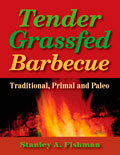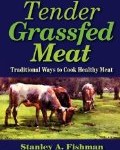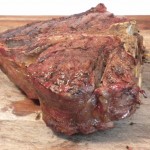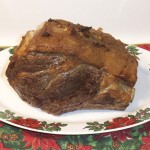Finding Grassfed Fat, and How to Add Good Fat to Lean Meat
By Stanley A. Fishman, author of Tender Grassfed Meat
All too often, when shopping for grassfed meat, I find myself asking, “Where’s the fat?â€
The ugly truth is that far too much grassfed meat has all the visible fat trimmed off, and has very little fat in the meat.
The most nutrient-dense component of grassfed meat is the fat. The fat of grassfed animals is rich in omega-3 fatty acids, conjugated linoleic acid (CLA), and many other nutrients.
The fat also gives great flavor and enhances tenderness. The Weston A. Price Foundation advises always eating meat with fat. Traditional peoples, from the peoples of old Europe, to the Native Americans, to the Chinese, always ate meat with plenty of fat.
Yet many producers and sellers of grassfed meat trim off all the visible fat from their meat, and some deliberately raise their beef to be lean. For me, the most frustrating part of buying grassfed meat is getting meat with enough fat.
The key is to buy meat that comes with enough fat, both visible and internal. This involves careful shopping and lobbying producers. But sometimes, no matter what I do, the meat is just too lean. I have learned to compensate for this, just like our ancestors did.
If the fat is not in the meat, then you can bring the fat to the meat.
Tips for Buying Fattier Grassfed Meat
There are several indicators you can look at to find fattier grassfed meat. Here are some of them:
The Breed of Cattle
Genetics have a lot to do with the fat content in beef. Breeds that have been raised for meat, such as shorthorns and Angus, are much more likely to have more fat. Breeds that are noted for leanness, such as Galloway or Charolais, are much more likely to be very lean.
The Time of Year the Beef Is Processed
Traditionally, cattle were processed for meat in the late spring or early summer, after they had been eating the rich green grass of spring for as long as possible. This was the best natural way to put fat in the cattle, and meat processed at this time has more fat, more flavor, and more tenderness.
There are a number of ranchers and producers who only process their beef at that time of year, and freeze it. If you have enough freezer space, that is a particularly good time to buy a large quantity of meat.
I have also found bison and lamb processed after feeding on green grass for a while to be fattier, more tender, and more tasty.
The Philosophy of the Producer
The attitude and belief of the rancher actually raising the meat animal has a huge impact, as there is much they can do to make the meat fattier or leaner. If the producer brags about how lean and fat free their meat is, the meat is going to be very lean.
If the producer talks about the benefits of grassfed fat and why it is good to leave some fat on the meat, then your chances of getting fattier grassfed meat are a lot better.
If the producer praises the virtues of grassfed fat, and also praises the leanness of their meat, you may have a choice.
Ask!
Many producers and butchers carry both lean and fattier grassfed meat. I have found that just asking for the fattiest grassfed cuts they have makes a huge difference. Asking for fattier meat also tells a wise producer that the demand is out there, and may well increase the supply of fattier grassfed meat.
How to Add Good Fat to Lean Meat
Often, no matter what I do, the meat that is delivered is just too lean, or the meat available is just too lean. Fortunately, our ancestors often faced the same problem, and developed some solutions. Here are some of the solutions I use:
1.     Butter. Pastured butter is the best friend of lean meat. You can coat the meat with softened butter before cooking. You can sauté the meat in butter. You can baste the meat with butter. You can put butter directly on the hot meat when it is served at the table. All of these methods will improve the meat and give you the fat that should be eaten with it.
2.     Beef tallow, lamb tallow, and bison tallow. Tallow can be placed directly on roasting meat, so it can baste the meat as it cooks. You can also sauté meat in melted beef tallow. You can melt some tallow and use it to baste the meat as it cooks. You can melt some tallow in a roasting pan and roll the meat in the melted tallow before cooking.
3.      Bacon. You can place fat slices of bacon directly on a roast, or render the fat from bacon and use it for sautéing.
4.     Natural, unhydrogenated lard. You can rub softened lard all over the meat prior to cooking. You can sauté the meat in melted lard. You can place lard directly on top of a roast, and baste during the roasting.
Tender Grassfed Meat contains a lot of information on how to add fat to meat, and how to cook meat with the right amount of fat.
This post is part of Real Food Wednesday, Fight Back Friday, Monday Mania, and Fat Tuesday blog carnivals.
The Joy of Fat, Why We Lost It, and How to Get It Back
By Stanley A. Fishman, author of Tender Grassfed Meat
“People are missing out on the joy of fat. It keeps the meat tender, makes the meat taste so much better.â€
These words of wisdom came from my friend Brian, head of the meat department at my local market. Brian is not only a master butcher, he is a classically trained chef who studied in France and cooked in Denmark. Brian knows grassfed meat.
We were talking about customers who want all the fat trimmed off every piece of meat they buy. These customers and so many others are truly missing out on the joy of fat.
The Joy of Fat—Taste, Tenderness, Satisfaction, and Nutrition
The natural fat on a piece of grassfed meat cooks down into the meat, keeping the meat tender while adding fantastic flavor and nutrients. The wonderful smell given off by the roasting fat is the best appetizer on earth, causing our bodies to prepare for digestion, and the joy of a great meal. You can roast vegetables like potatoes, carrots, peppers, celery, etc. right in the same pan, and the melting fat will brown them, caramelize them, and give them incredible taste and flavor that goes so well with the meat.
There is also the joy of satisfaction. Meat and vegetables cooked with grassfed fat are the most satisfying food on earth. After a serving of this delicious food, full of all kinds of nutrients, hunger disappears and the urge to eat and eat and eat that plagues so many people disappears. You stop eating because you are satisfied, and no longer want to. When your body has the nutrients it needs, the desire to eat is gone.
The fat from grassfed animals and wild fish has the natural ratio of omega-3 to omega-6 essential fatty acids, and contains many other beneficial substances that factory meat and farmed fish lack. This fat was cherished by our ancestors, who ate as much of it as they could, and our bodies have evolved to know how to use it. It is prime fuel for our bodies. More information on the benefits of animal fat is explained here.
All of the healthy peoples studied by Dr. Weston A. Price ate plenty of animal fat, from animals that were wild or pastured. Most of them ate as much fat from wild seafood as they could get. These healthy people had perfect teeth, and were free from the chronic diseases that plague us.
How the Joy of Fat Was Replaced by the Fear of Fat
Most people are afraid of animal fat. They fear that eating animal fat will clog their arteries with cholesterol, causing heart attacks and strokes. They fear that eating animal fat will make them fat. They fear that eating animal fat will give them all kinds of diseases. All of these fears are just not true. In fact, cholesterol is beneficial, as explained in this article: Cholesterol: Friend or Foe?
So why does the government, the news media, the medical profession, the food industry, the drug industry, and the educational system, all support and repeat this misinformation?
The answer is very simple—money.
It has been written that “Money is the root of all evil.†There is much truth in that statement.
Extensive marketing campaigns, backed by many “studies†based on incomplete, mistaken, or biased research, convinced the public to fear real fat. When people were convinced to avoid the most important nutrient, it had to be replaced with something. This created several very lucrative markets.
The Food Industry Makes Money from the Fear of Fat
Real animal fat satisfies hunger like no other food. When you remove fat, people are hungry because they are not getting the nutrients their bodies crave. When people are hungry they buy more and eat more.
This process was described beautifully by my friend Sarah Pope, of the Healthy Home Economist blog:
“. . . some brands of commercial ice cream are now called “dairy dessert” instead of ice cream as they have lowered the butterfat content so much it can no longer even qualify as ice cream. This is deliberate because when the butterfat content decreases, the customer EATS MUCH MUCH MORE and the ice cream becomes more addictive as sugar replaces the butterfat! . . . You can get addicted to sugar but you can’t get addicted to butterfat.â€
Addiction and overeating makes a fortune for the food industry. The food industry favors products based on grains, sweeteners, artificial flavors and preservatives, and modern vegetable oils. These ingredients are highly processed, and the raw materials are very cheap for the food industry. The products they create with these ingredients lack vital nutrients, so the customer’s hunger will never be satisfied. Yet the ingredients are often addictive, so the customer will buy more and more of the product. This is why people can eat a whole bag of cookies and still be hungry.
Fear of Fat Makes a Fortune for the Diet Industry
If you look at old photos of Americans at the beach taken during the early 20th century, you will be astonished at how fit almost everybody was. Obesity was very rare. Prior to the demonization of animal fat, most doctors had a simple and effective cure for overweight people who wanted to lose weight. Reduce the amounts of carbs and sugars, and eat a high-fat diet full of butter and other animal fats. These kinds of diets worked, because nothing satisfies like animal fat. There was no diet industry.
Once people became afraid of animal fat, these time-tested, high-fat diets went out the window, and the diet industry came to life. The diet industry has created a myriad of ways to lose weight, based on counting calories, eating a low-fat, nutrient-poor diet, and exhausting exercise. All of these programs are expensive. All of these programs are difficult to do, which allows the victim to be blamed when the program does not work. Typically, these programs work well for a few people, and some may lose a lot of weight on them, but the weight always comes back, and the victims end up fatter than ever, and are soon looking for a new diet program, which is always there. The severe malnutrition and exhaustion that many experience during such programs often leads to chronic illness, sometimes death.
The Medical Industry Makes a Fortune from the Fear of Fat
The fats of wild and pastured animals contain many nutrients that are found nowhere else, except in wild fish. Our bodies need these nutrients for the natural functions of the body to work properly. One of the most vital functions of our bodies is the immune system. When the immune system is compromised, people get sick with all kinds of illnesses. Another important function is the ability of the body to repair itself. Most of the symptoms of old age are greatly worsened when the body’s repair functions are compromised, again leading to illness, including the failure of organs, bones, joints, and the mind.
This causes people to seek relief from the medical profession, leading to countless prescriptions, surgeries, tests, radiation sessions, and other procedures that are expensive and often harmful. Many medical interventions never cure anything, but require the “patient†to have ever increasing amount of “care,†with huge profits being made from the “patient’s†illness. Many medical interventions create a new problem in the “patient’s†body, which requires yet more medical interventions, which creates yet more problems, until the cycle is finally stopped by death.
How We Can Rediscover the Joy of Fat
I did relearn the joy of fat. The first step I took was to follow the dietary guidelines of the Weston A. Price Foundation.
The second step was to find grassfed meat, and cook it with the fat on. I also learned the way of our ancestors and cooked all meat and vegetables with plenty of pastured animal fat, like pastured butter, real cream, beef tallow, duck fat, pork lard, lamb tallow, bison fat, and others.
If you are not used to eating fat, it is best to start with small amounts, so your system may get used to it. Use the best, most natural ingredients you can afford, and you too may rediscover the joy of fat.
This post is part of Monday Mania and Real Food Wednesday and Fight Back Friday blog carnivals.
Call It Medical, Not Mediterranean
By Stanley A. Fishman, author of Tender Grassfed Meat

 photo credit: Roby Ferrari
photo credit: Roby Ferrari
Most medical institutions, and organizations recommend what they call the “Mediterranean diet†as ideal for human health. There is no denying that many of the European peoples living on the Mediterranean are healthier than Americans, though that is not much of an accomplishment, given how much factory food is eaten here.
The problem is that the “Mediterranean diet†pushed by the medical establishment has almost nothing to do with the real diet of the European peoples who live on the Mediterranean.
The “Mediterranean diet†recommended by the medical industry is very similar to the horrid “food pyramid†advocated by our government (though there are a few differences). The real Mediterranean diet had nothing in common with the food pyramid.
Contrary to the propaganda, the healthy peoples of the Mediterranean prized fatty pork, lamb, and goat, ate large quantities of unpasteurized full-fat cheese and milk, made heavy use of salted fish and brined vegetables, salty and fatty sausages, used butter and pork lard copiously in their traditional recipes, looked down on whole grains, ate small quantities of pasta as a side dish, hunted wild game such as rabbits and small birds, often went without vegetables, and generally ate as much saturated animal fat as they could get their hands on.
What Is the “Mediterranean Diet�
There are a number of European countries and several large islands that border the Mediterranean Sea, including, Spain, Italy, France, Croatia, Serbia, Greece, Crete, Corsica, Malta, Sardinia, and Sicily. I have studied the traditional cuisines of all these countries, including their Mediterranean regions. While each cuisine is unique, they do have a lot of common characteristics.
The Medical establishment claims that the traditional diets of the Mediterranean peoples had the following characteristics:
- Low salt
- Low fat, rejecting animal fats in favor of fats like olive oil and canola oil
- Ate red meat in tiny portions, only a couple times a month
- Ate mostly fruits, vegetables, legumes, whole grains
- Ate fish at least twice a week
- Avoided all saturated fats
- Ate 9 or more servings of fresh fruits and vegetables a day
Basically, none of these characteristics are accurate.
Mediterranean Peoples Ate Lots of Saturated Animal Fats
Almost every peasant kept a small herd of goats, or sheep. These animals were raised mostly for their milk, which was drunk raw, made into curds, made into a huge variety of full-fat cheeses, and widely used in cooking. The milk was unpasteurized and always full-fat. These dairy products were a huge part of their diet. The meat prized by the Mediterranean people was not lean, but fatty, consisting mostly of pork, lamb, and goat. Butter and lard were widely used in cooking, along with olive oil. While olive oil was widely used, it was used in addition to, not instead of animal fats. Canola oil was unknown, not even existing until it was invented in the late 20th century.
Mediterranean Peoples Ate Lots of Salt
Salting food was the main way of preserving food, given the warm climate, and the Mediterranean peoples were masters of salting fish, cheeses, and meat. They had hundreds of traditional recipes for meat sausages, which were heavily salted to preserve them, and contained a large amount of animal fat. In the inland areas, most of the fish consumed was salted, and dozens of traditional recipes were developed for cooking salted fish. In fact, salted fish is still very popular, even though fresh fish is now widely available.
Mediterranean Peoples Ate Red Meat Whenever They Could Get It, Eating As Much of It As They Could
Meat is perhaps the food most prized by the peoples of the Mediterranean. Meat was often difficult to get, as the flocks of sheep and goats were needed mainly for their milk, and the people were often poor. Nevertheless, pigs were widely raised, and made into a multitude of sausages, which were eaten throughout the year. There are thousands of recipes for pork roasts, chops, stews, and braises. Lambs and goats would be barbecued whole for special occasions and holidays. The meat eaten on these occasions was not served in tiny portions, but feasted on. Various kinds of grilled lamb were a beloved specialty in every one of these countries. Veal was also a favorite, when available. Most peasants hunted the abundant rabbits, and various small birds, and ate them whenever possible.
Most of the people would have liked to eat meat much more often than they could. In fact, many of the immigrants that came to the USA from these countries were lured to the USA by the stories they had heard of cheap, abundant meat. But even in Malta, where most meat had to be imported and was very expensive, meat was eaten at least once a week.
Mediterranean Peoples Were Often Short of Vegetables, and Put Fat on their Bread
Because of the often arid climate, vegetables and fruits were only available in season, though many were preserved by drying. There were a number of times during the year when little fresh produce was available. Beans and potatoes were widely available, and often eaten. Grains usually meant bread, which was usually not whole grain, and usually eaten with butter, or olive oil, or pork lard. In fact, raw pork lard smeared on bread is a traditional combination in rural Italy.
Mediterranean Peoples Did Not Eat Fish at Least Twice a Week
Most of the people in these countries lived inland, often in the mountains, and avoided the coast, though there were some coastal cities and fishing villages. There were two reasons for this. First, many coastal areas were infested by malaria-carrying mosquitoes. Second, pirates were a real danger during most of the history of this region. These pirates specialized in raiding coastal villages, and most of the villagers responded by moving inland, to the easily defended hills and mountains. Most of the food in these areas was of animal origin. Fish was eaten (especially when meat was forbidden during Lent and other such religious events), but it was usually salted or dried. Because of the lack of roads, it was very hard to get fresh fish to the hills and mountains, even on islands like Corsica and Sardinia.
Mediterranean Peoples Did Not Eat Nine or More Servings of Fresh Produce a Day
As discussed above, the variety of available fruits and vegetables was limited, and seasonal. The supply of food was often limited, and it is doubtful that most people ate nine servings of anything a day. Most calories came from dairy products, the full-fat cheeses and milk produced by the herds.
The Origin of the Mainstream “Mediterranean Diet “Was Based on What the People Ate During a Wartime Food Shortage
The first doctor to write of the “Mediterranean diet†was stationed in poor coastal areas of Italy, in 1945, during the last days of World War II. Food—especially the most valuable foods such as meat and butter—were in very short supply, and the hungry people ate whatever they could get. If they ate their bread dry, it was because they could not find fat to put on it, because of the food shortage. To portray what they ate during this wartime food shortage as their traditional diet was a mistake.
The “Mediterranean Diet†Is Really the Medical Diet
The medical and food industries have tried to portray the low-fat, low-protein, high-carb diet they favor as being traditional. It is not traditional. In fact, no traditional people anywhere, in all of history, ever ate a diet like this. “Mediterranean†sounds a lot better than “medical,†but the diet they advocate is the medical diet. The only thing the medical diet has in common with the Mediterranean diet is the first three letters of their names.
This post is part of Real Food Wednesday, Fight Back Friday and Monday Mania blog carnivals.
« Previous Page

 Photos of recipes from the new book Tender Grassfed Barbecue
Photos of recipes from the new book Tender Grassfed Barbecue
 Photos of recipes from the cookbook Tender Grassfed Meat
Photos of recipes from the cookbook Tender Grassfed Meat


